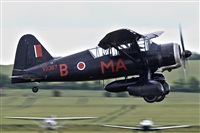|
|
|
|
|
|
|
|
|
|
|
|
|
|
Remarks |
|
|
solo en Duxford se pueden ver estas escenas....
|
|
|
|
|
|
|
|
 |
|
1098
views |
|
|
|
|
|
|
|
|
|
|
|
|
|
|
|
|
|
|
Remarks |
|
|
Vista a tres cuartos por detras del Lysander con muchas nubes y poco sol. Algo interesante debe venir por la izquierda, a juzgar por la actitud de los spotters.
|
|
|
|
|
|
|
|
|
|
|
|
|
|
|
|
|
|
|
|
|
|
Remarks |
|
|
Curiosa perspectiva la que ofrece este Lysander evolucionando en el Flying Legends. Parece tener el ala izquierda mucho más larga que la derecha. La realidad es que este avión tiene una envergadura considerable, como se puede apreciar en el ala izquierda. La derecha, por el diedro y por la perspectiva de la foto, parece ser más pequeña. Por descontado las dos son iguales.
|
|
|
|
|
|
|
|
|
|
|
|
|
|
|
|
|
|
|
|
|
|
Remarks |
|
|
El Lysander fue muy utilizado en misiones de apoyo a los espías y resistentes franceses durante la IIGM. Sus arriesgadas misiones las acostunbraba hacer de noche(de ahí su pintura negra) en los que volaba a la Francia ocupada trayendo o recogiendo espías o colaboradores franceses y también recogía pilotos aliados derribados que la resistencia francesa mantenía ocultos de los alemanes. Para ello estaba diseñado para realizar aterrizajes y despegues cortos en terrenos mal preparados. Una escalera adosada al lado del fuselaje permitía la rápida subida o bajada de las personas que recogía.
|
|
|
|
|
|
|
|
|
|
|
|
|
|
|
|
|
|
|
|
|
|
Remarks |
|
|
Configuración de toma del Lysander.
|
|
|
|
|
|
|
|
|
|
|
|
|
|
|
|
|
|
|
|
|
|
Remarks |
|
|
Uno de los Hurris que volanron en el día calentando motor antes del despegue.
|
|
|
|
|
|
|
|
|
|
|
|
|
|
|
|
|
|
|
|
|
|
Remarks |
|
|
Una autentica maravilla en vuelo y uno de los aviones más importantes de la historia.
|
|
|
|
|
|
|
|
|
|
|
|
|
|
|
|
|
|
|
|
|
|
Remarks |
|
|
70 aniversario de la Batalla de Inglaterra
|
|
|
|
|
|
|
|
|
|
|
|
|
|
|
|
|
|
|
|
|
|
Remarks |
|
|
Uno de los 5 Hurricanes que pudimos ver volar en el festival del aniversario de la BoB
|
|
|
|
|
|
|
|
|
|
|
|
|
|
|
|
|
|
|
|
|
|
Remarks |
|
Conmemoración del 70 aniversario de la Batalla de Inglaterra.
Vemos a esta preciosidad de avión en final para aterrizar con sus cuatro mini-flaps desplegados.
|
|
|
|
|
|
|
|
|
|
|
|
|
|
|
|
|
|
|
|
|
|
Remarks |
|
Avión de caza británico deserrollado en los años treinta.
70Aniversario de la Batalla de Inglaterra
IWM, Duxford.
|
|
|
|
|
|
|
|
|
|
|
|
|
|
|
|
|
|
|
|
|
|
Remarks |
|
Quedan pocos Hurricane en vuelo, pero ninguno como este. Es una variante naval para portaviones, con gancho de apontaje.
Construido en 1940, estuvo "en el suelo" entre 1943 y 1995, lo que demuestra que cualquier aparato puede ser restaurado con dinero y dedicación.
Aconsejo la pagina del propietario, una colección impresionante y realmente atípica por la rareza de muchos de los aparatos que posee:
http://www.shuttleworth.org/
|
|
|
|
|
|
|
|
|
|
|
|
|
|
|
|
|
|
|
|
|
|
Remarks |
|
|
Nada mas y nada menos que 78 años tiene este avión. Fué el último Gladiator construido.
|
|
|
|
|
|
|
|
|
|
|
|
|
|
|
|
|
|
|
|
|
|
Remarks |
|
Otra de las maravillas que se pueden ver volando en Flying Legends. Este Hind es parte de la Shuttleworth Collection.
[Canon EOS 40D + Canon EF 100-400 4.5-5.6L IS USM]
|
|
|
|
|
|
|
|
|
|
|
|
|
|
|
|
|
|
|
|
|
|
Remarks |
|
|
Cuiriosa formación de dos aviones contemporaneos aunque de caracteristicas completamete distintas. El Lysander era un aparato utilitario para cooperación con tierra, famoso por su dificil manejo y el Gloster Gladiator era un caza extremadamente maniobrable.
|
|
|
|
|
|
|
|
|
|
|
|
|
|
|
|
|
|
|
|
|
|
Remarks |
|
Perteneciente a The Shuttleworth Collection, este modelo fue utilizado durante la IIGM para introducir espias en suelo enemigo, por eso su color negro
Nuevo modelo en AC
|
|
|
|
|
|
|
|
|
|
|
|
|
|
|
|
|
|
|
|
|
|
Remarks |
|
|
Hawker Hind de la colección Shuttleworth, marcado K5414, cn 41H/81902. Una verdadera joya del período entreguerras volando en Duxford.
|
|
|
|
|
|
|
|
|
|
|
|
|
|
|
|
|
|
|
|
|
|
Remarks |
|
|
K7985, Perteneciente a la Shuttleworth Trust, es una maravilla verlo volar, y más aún imaginar cómo pudieron enfrentarse a la Luftwaffe en Malta. Historia viviente.
|
|
|
|
|
|
|
|
|

